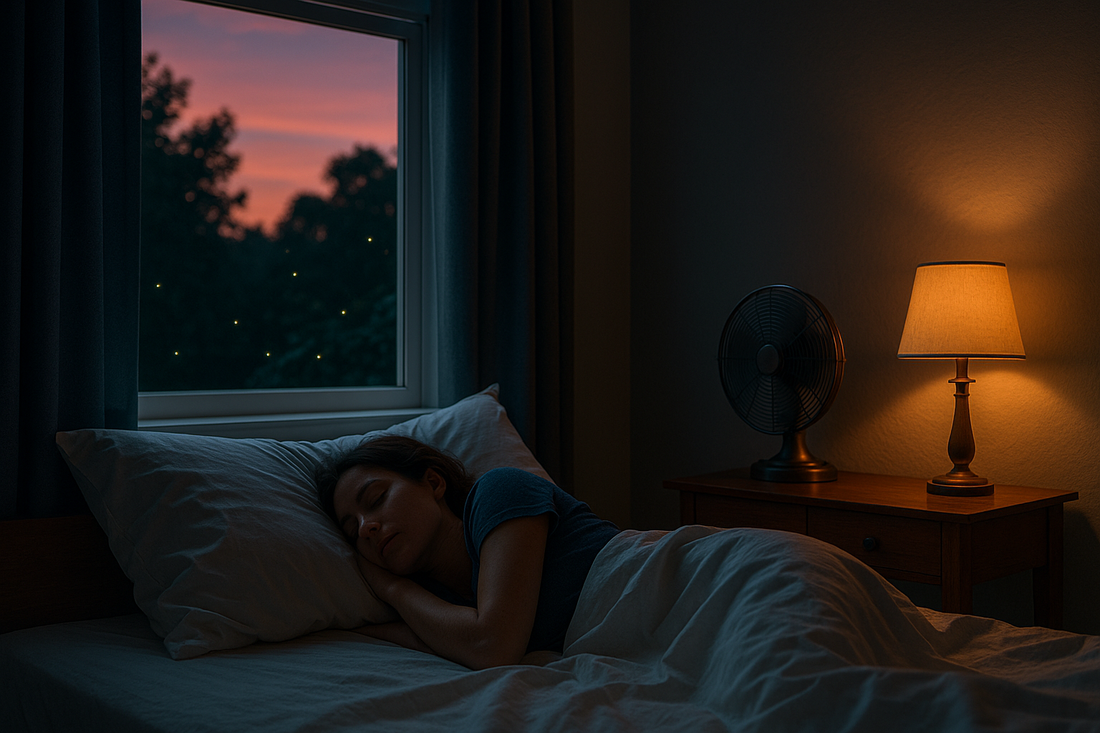Long days and warm nights make summer memorable, but can unsettle sleep. Below is a quick science-based look at why the season challenges our biology and how simple tactics and wearable neurotech can help.
Why Summer Skews Sleep
Light lingers too late. Bright evening light suppresses melatonin and pushes the body clock later. An extra hour of daylight near bedtime trims nightly sleep by roughly nineteen minutes on average [1]. Long photoperiods also delay and shorten melatonin release [2].
Early sunrise ends sleep early. Dawn light penetrates closed eyelids and triggers cortisol release, nudging you awake before your alarm and shortening overall sleep [1].
Heat and humidity block deep rest. Core body temperature must fall slightly for sleep onset. When nighttime air stays above 30 °C (86 °F), people sleep about fourteen minutes less and wake more often [3]. High humidity slows sweat evaporation, cutting slow-wave and REM sleep [4].
Seasonal noise. Fireworks, outdoor parties, and late traffic push environmental noise above 40 dB, a level linked to more awakenings and lighter sleep [6].
Allergy peaks. Summer pollen inflames airways, and allergic rhinitis lowers sleep efficiency and raises daytime fatigue [7].
Lifestyle drift. School breaks, late dinners, and extra screen time foster social jet-lag—the gap between when we want to sleep and when we must wake. Large datasets show average bedtimes move later in June and July while wake times stay fixed, eroding weekly sleep totals [1].
Science-Backed Tactics
|
Challenge |
Targeted fix |
|
Evening light |
Dim indoor lighting two hours before bed, use blackout curtains, wear a lightweight sleep mask. Seek bright outdoor light within one hour of waking to anchor circadian timing [5]. |
|
Hot bedroom |
Keep 60–67 °F (16–19 °C). Run a fan or AC, use breathable cotton or bamboo sheets, take a lukewarm shower 30–60 min before lights-out. |
|
Humidity |
Hold relative humidity near 40–50 %. Dehumidifier or AC helps where nights stay muggy. |
|
Noise |
Close windows, run a steady fan or white-noise machine. |
|
Allergens |
Shower before bed, wash bedding weekly in hot water, use a HEPA filter. |
|
Irregular schedule |
Keep one consistent wake time all week. If you stay out late, return to your usual bedtime the next night. |
|
Wired mind |
Wind down for thirty minutes without blue screens: light stretches, reading, or slow breathing. |
Where Wearable Neurotech Fits
Sleep hygiene solves a lot, yet some nights the brain stays alert despite our best efforts. That is where we come in. Elemind uses a comfortable headband that reads your brain’s electrical activity in real-time and delivers barely audible, precisely timed sound pulses. These pulses guide brainwaves from alert beta toward sleep-promoting slow oscillations. With our headband you can use this support, on-demand, at bedtime or after unwanted awakenings, complementing the environmental steps above.
Quick Summer Sleep Checklist
-
Block evening light, seek morning light.
-
Cool the room below 67 °F and reduce humidity.
-
Keep one consistent wake time.
-
Wind down for thirty minutes without blue screens.
-
Use our Elemind headband for faster sleep, on-demand.
Enjoy long evenings and bright mornings without sacrificing sleep.
References
-
Giuntella O, Mazzonna F. Sunset time and the economic effects of social jet-lag. J Health Econ. 2019;65:210-226.
-
Vondrasová D, Hájek I, Illnerová H. Exposure to long summer days affects human melatonin and cortisol rhythms. Brain Res. 1997;759:166-170.
-
Minor KL, Bjerre-Nielsen A, Jónasdóttir SS, Lehmann S, Obradovich N. Rising temperatures erode human sleep globally. One Earth. 2022;5:534-548.
-
Manzar MD, Sethi M, Hussain ME. Humidity and sleep: a thermal perspective. Biol Rhythm Res. 2012;43:439-457.
-
Figueiro MG, et al. Daytime light exposure improves sleep and mood in office workers. Sleep Health. 2017;3:204-215.
-
Basner M, McGuire S. WHO Environmental Noise Guidelines: systematic review on noise and effects on sleep. Int J Environ Res Public Health. 2018;15:519.
- Craig TJ, Teets S, Lehman EB, Chinchilli VM. Sleep disturbance with seasonal or persistent allergic rhinitis. Ann Allergy Asthma Immunol. 2009;103:344-349.


